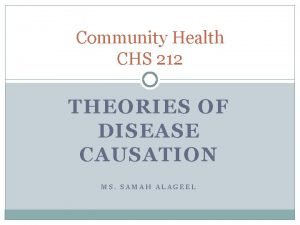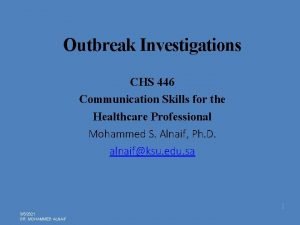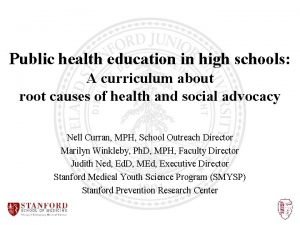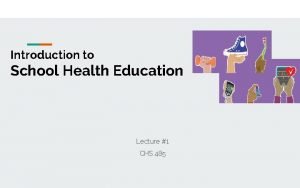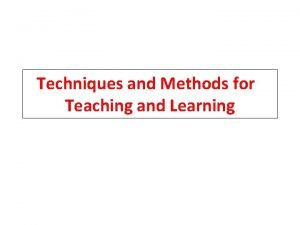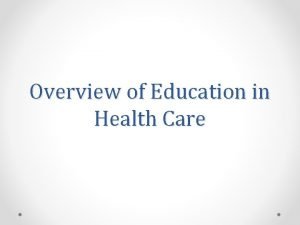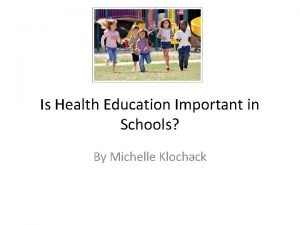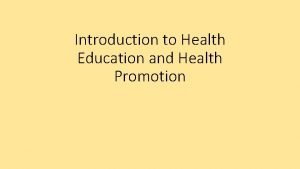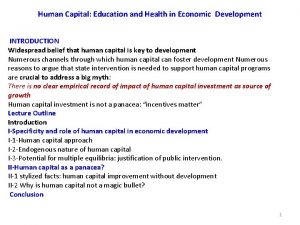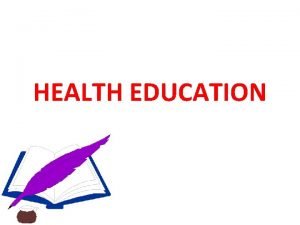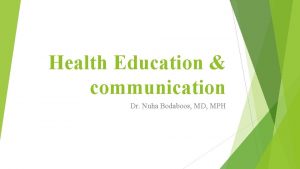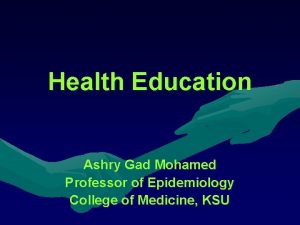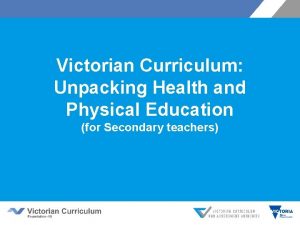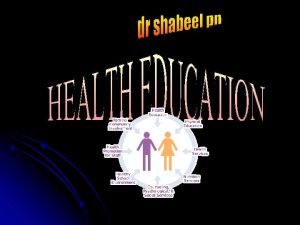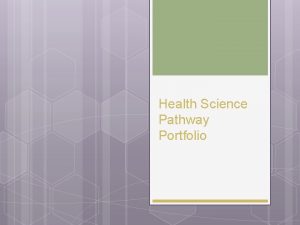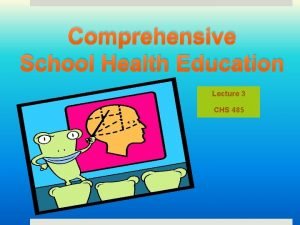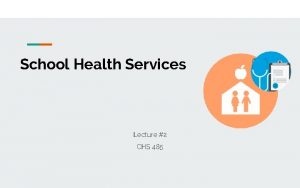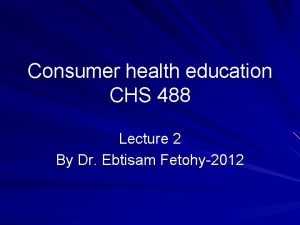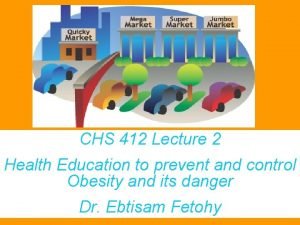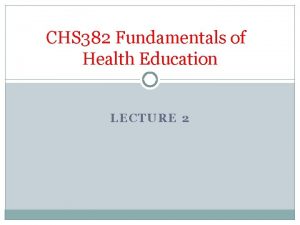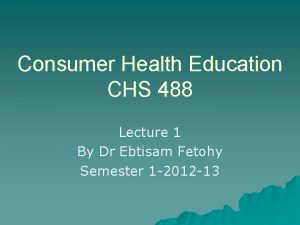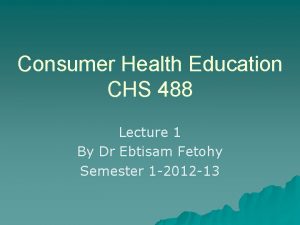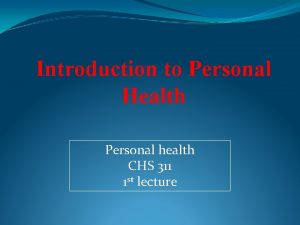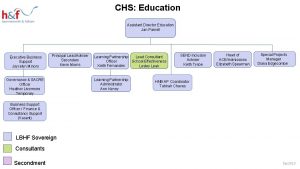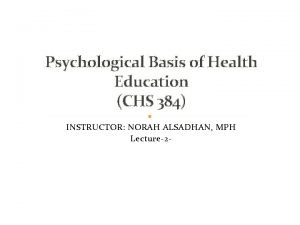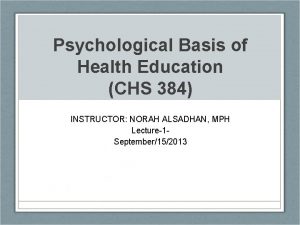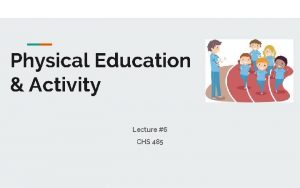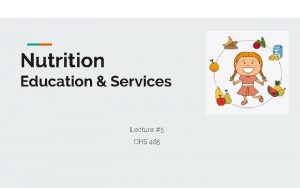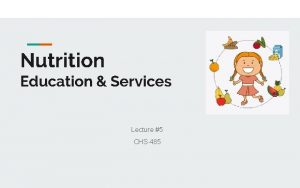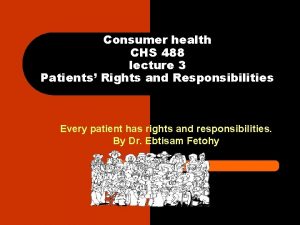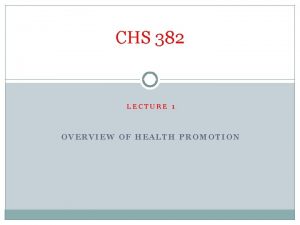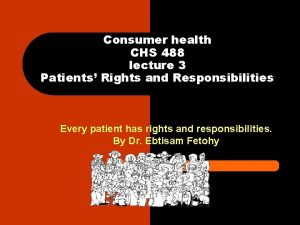Introduction to School Health Education Lecture 1 CHS










































- Slides: 42

Introduction to School Health Education Lecture #1 CHS 485

Health is a very broad concept ● Health is influenced by a number of interrelated and influential factors, called: Determinants of Health. ● Health is described as: “ A state of complete physical, mental, and social wellbeing and not merely the absence of disease or infirmity” WHO, 1947

What are the biggest health challenges confronting kids & youth (threats to health)?

Priority Health Behaviors ● Public Health Professionals at the CDC identified six priority health behaviors based on the demonstrated link between these behaviors & leading causes of illness and death; in order to guide educational programmers & intervention specialists. Tobacco use Alcohol & drug risks Poor eating habits Sexual behaviors Physical inactivity Behaviors results in intentional or unintentional injuries

Why Health Education is essential from the early age? ❖ Health education shapes individual’s knowledge, abilities, and positive attitudes. It teaches people about physical, social, mental, and emotional health and encourages them to improve and maintain healthy behaviors, to prevent illnesses and diseases, and decrease unsafe and unhealthy behaviors. to

Why Health Education is essential from the early age? ❖ Studies have shown that, the percentage of obese children in the United States has dramatically increased over the past thirty years. The CDC states that ''children with obesity are at higher risk for having other chronic health conditions and diseases that impact physical health, such as asthma, sleep apnea, bone and joint problems, type 2 diabetes, and risk factors for heart disease''. So, the connection between early life experiences and later health is becoming increasingly clear. Hence, health education is an essential component to be imbedded in early age to avoid & control negative consequences.

Why at Schools ? ! 1. Schools are one of the most efficient systems for reaching children and youth to provide health services and programs. Schools represent the only public institution that can reach nearly all young people. 2. Schools provide a setting in which friendship networks develop, socialization occurs, and norms that influence behavior are developed and reinforced. 3. Integrating health services and programs more deeply into the day-to-day life of schools and students represents an untapped tool for raising academic achievement and improving learning.

Learning & Health are interrelated. . . ● Academic achievement is an excellent indicator for the overall well-being of youth, and a primary predictor and determinant of adult health outcomes. ● Individuals with more education are likely to live longer; experience better health outcomes; and practice health-promoting behaviors such as exercising regularly, refraining from smoking, and obtaining timely health care check-ups and screenings.

It is time to truly align the sectors and place the child at the center. Both public health and education serve the same students, often in the same settings. We must do more to work together and collaborate. —WAYNE H. GILES, DIRECTOR, DIVISION OF POPULATION HEALTH, NATIONAL CENTER FOR CHRONIC DISEASE PREVENTION AND HEALTH PROMOTION, CDC

Proactive collaboration Due to the complexity of the health & academic problems confronting students, it is not reasonable nor realistic to expect that schools can address them without support. These challenges require the collaborative efforts of families, communities, health care providers, legislators, media and others… There are no simple solutions nor direct path to follow, schools can provide a focal point for many such efforts.

Discussion If you were planning to assess school health, what areas you are likely to look for? In other words, what do you think are the most important aspects of school health?

Coordinated School Health Approach

Coordinated School Health Program (CSHP) ● Coordinated school health programs are used to combine health promoting practices in the school setting. ● The Coordinated School Health model was created by the Centers for Disease Control and Prevention. This model consists of a set of policies, procedures and protocols that promote health education for the entire school, students and staff.

Coordinated School Health Program (CSHP) ● The CSH model includes eight critical components: Health School Healthy health school services environment education School nutrition services Physical education Counselling, psychological & social services Health Family & community involvement promotion for faculty & staff.

Coordinated School Health Program (CSHP) ● CSHP puts both student health and academic achievement at the heart of the matter and provides an efficient and effective way to improve, protect, and promote school success and the well being of students, families, and professionals in the education system. ● The teacher serves as an important role in educating students on the importance of healthy behaviors and lifestyles in order to decrease barriers that may impact learning.

Importance of a coordinated approach (CSHP) A coordinated approach is the best approach to manage complex student health challenges. CHS has the capacity to: 1. Provide a way for school health promotion activities to be systematic and intentional. 2. Health messages are communicated with consistency and reinforced through multiple channels. 3. Maximize the impact of all available expertise and resources directed toward risk reduction & health promotion. 4. Effective utilization of public facilities to promote health. 5. Reduction of waste that results from the duplication of services for health issues. And so, the cost will be minimized. 6. Health advocates are better able to focus their efforts; since communication & collaboration across professionals in and out the school are enhanced.

1. Comprehensive School Health Education A program of quality health instruction is focused on enabling and empowering students to gather accurate Health information, evaluate attitudes that influence personal and community health and practice skills necessary to integrate health enhancing practices into daily living. ● Health Education is the foundation of coordinated school health program. ● It is organized to include planned, sequential, developmentally appropriate, and cross-curricular activities.

1. Comprehensive School Health Education ● Quality health instructions must contain activities that bridges all 3 domains of learning: 1. Cognitive 2. Affective 3. psychomotor or skills With the use of appropriate learning materials, equipment and books. ● Scholarly analysis has confirmed that more hours of formal health instruction are necessary to produce change in the affective domain than in either the cognitive or psychomotor domains. ● 40 -50 h. Of formal health instruction are necessary to produce stable, improved outcomes across all three domains.

1. Comprehensive School Health Education ● This includes educating students on several topics, involving alcohol and drug abuse, personal health, mental and emotional health, sexual health and nutrition. Students learn how to make health-promoting decisions and learn why those decisions are important.

Essential elements for a comprehensive school Health Education ● School community develops a planned , sequential, developmentally appropriate curriculum. ● The curriculum includes learning activities that enable learners to actively practice skills to adoption of health promoting behaviors. ● Parents are actively involved in the health education program. ● Certificated health educators are employed to deliver or supervise the delivery of HE. ● Community health agencies participate in HE. ● There is health related staff development program (continuous training).

2. School Health Services Health services focus on preventing illness, promoting health, and providing care for students within the school setting. School nurses work with the student, family, school staff and other health care providers to maintain best possible care for students. ❑ School health services Include range of policies and programs designed to assess the health status of students and measures to protect health of children. ❑ School is the ideal location for basic screening to identify deviations from normal growth and development learning process. and problems that exert a negative influence on the

2. School Health Services ● The school health educator assume primary responsibility for leadership in the component of the coordinated school health program. with the support of school staff, community agency professionals , and physicians. Role of the school health educator: 1. Assess student health needs and problems. 2. Plan school based activities that respond to identified needs. 3. Assure rigorous implementation of care plans. 4. Evaluate the impact of the intervention on the health status and achievement of the student.

Essential elements for a quality school health services ● School community develops plans and policies concerning : Prevention and control of communicable diseases, provision of emergency care, first aids, and health status appraisal of all students. ● Services should respond to the needs of students with special needs. ● Screening, referral, management, and record keeping for students with areas: vision, hearing, immunizations, height/weight, dental health, scoliosis. . . etc.

Essential elements for a quality school health services ● Availability of staff development activities to promote sanitation and compliance with universal precaution recommendations. ● Inter-agency networks should be established to assure quality and collaborative services for students. ● Licensed staff members are employed. ● Employed professionals participate in a staff development programs.

3. Healthy School Environment ➔ Physical condition of the buildings, playgrounds, sport facilities. ➔ Vehicles, & transportations, pedestrian areas. ➔ Management of noise, temperature, lighting. ➔ Air & water quality ➔ Policies on harmful objects, e. g. “Bully-free zone“ ➔ Enforcement of tobacco free campus policies. ➔ In addition to; Social and psychological climate of schools Negative consequences: Leaky roofs, problems with heating and ventilation, lack of cleanliness, excessive usage of cleaning chemicals can trigger health problems (Asthma & allergies ) which can increase absenteeism and reduce academic performance rate.

Essential elements for Healthy School Environment ● School maintains compliance with standards for cleanliness, lighting, ventilation, management of environmental hazards, …etc. ● Adopted policies are consistently implemented to ensure safe , tobacco , alcohol, and other drug-free school campus. ● Availability of Community/school health advisory council or committee. ● School administration supports the coordinated school Health program. ● Health promotion activities are extended throughout the district and community.

4. School Nutrition Services The school nurse, teachers, and staff promote nutrition by educating and promoting healthy eating habits. By focusing on: 1 - Serving quality, nutritional meals within budget. 2 - Supporting nutrition education curriculum to support nutritional intake of students.

4. School Nutrition Services ● The school health educator / nurse provides information to food service indicating whether students have specific food allergies for example lifethreatening peanut allergy, in order to promote student safety. ● Teachers are encouraged to using fruits and vegetables to teach students about colors, learning about weights, and counting calories & nutritional values.

Essential elements for School Nutrition Services ● School provides breakfast & lunch meals. ● The provided meals are in compliance with the dietary guidelines. ● Kitchen and cafeteria facilities are used as nutrition education learning laboratories. ● A qualified personnel is employed in the food service program. ● Nutritionally sound products are merely sold throughout the school. ● Nutrition information; menu planning is shared with faculty, staff, parents, food service staff and students. ● Food service personnel acts as a resource person for nutrition education curriculum matters. ● An advisory council is organized to support and inform the school nutrition program.

5. Counseling, Psychological and Social Services ● Counsellors, Psychologist, and social worker contribute in school health promotion. This involves working together in order to identify and address student ● mental, emotional and behavioral problems. This focuses on assessments, interventions and referrals for improving the student's and families cognitive, emotional, behavioral, and social needs. - Issues may include: ● Emotional & self esteem ● Weight problems ● Academic stress & test anxiety ● Relationship issues

Essential elements for Counseling, Psychological and Social Services ● An appropriate number of licensed professionals employed to meet the counseling, psychological and social services need of all students. ● A developmentally appropriate planned sequential guidance and counseling program is applicable. ● Availability of student assistance program. ● School district and community members are collaborated in the development of an interagency network of counseling, psychological, & social service providers. ● Students have an access to school/community linked services that support academic outcomes as Individual counseling, group counseling, crisis counseling. ● Professionals provide consultation & staff development to update & inform curricular matters. ● Interdisciplinary cooperation is established properly to identify students at risk.

6. Physical Education Physical educators, teachers and staff work together to meet physical education goals by providing information needed and skills required for lifelong habits of physical activity. Programs should be developed to targeting cardiovascular health, muscular endurance, flexibility, strength, balance and good posture. Schools are an ideal location for students to get the recommended 60 minutes of PA each day.

6. Physical Education Regular activity among children and youth helps: - build healthy bones, muscles, and joints. - Control weight. - Support development of lean muscle mass. - Reduce feelings of depression and anxiety. - Increase concentration and improve scores on tests of math, reading & writing skills.

Essential elements for Physical Education ● A planned sequential physical education curriculum is implemented. ● A curriculum is developed with attention to the international physical education standards. ● Ensure the participation of all students in an organized PE program on a daily basis. ● An ongoing program of health related fitness assessment is applicable. ● Physical education curriculum should focus on lifetime activities rather acquisition of team sport skills. ● Physical education staff collaborate with health personnel to record results of fitness assessments. ● Certified teachers of PE is on place.

7. Health Promotion for faculty & staff - Schools have well-maintained facilities & professional resources to plan & implement quality programs to promote the health of the faculty and staff. - School based health promotion programs for staff have been shown to: decrease absenteeism, increase employee retention, improve morale, increase productivity and motivation to practice healthy behaviors, provide healthy role models for students. ● Do health promotion programs include employee assistance activities, screening, referral and education? ● Have policies and incentives been developed to promote faculty/ staff participation in health promotion activities?

8. Family and Community Involvement Today’s health and social problems require that no one agency or group be blamed or held responsible for intervening in such matters in the absence of other stakeholders. Student risk behaviors are influenced by a complex set of variables which require a collaborative efforts. Key stakeholders are: parents, Close parent-child relationships characterized by mature parenting skills, shared family activities, positive role modeling. Also the influence of friends and peers, which increases during adolescence.

8. Family and Community Involvement ● Have policies and protocols been established to encourage active parental involvement in school health activities? ● Does an active school-community coalition or committee meet on a regular basis to address student health problems and curriculum matters, as well as to plan health promotion activities?

Expended model : Whole School, Whole Community, Whole Child (WSCC) The Whole School, Whole Community, Whole Child (WSCC) model expands on the eight elements coordinated school of CDC’s health (CSH) approach and is combined with the whole child framework. CDC developed this expanded model to strengthen a unified and collaborative approach designed to improve learning and health in schools.

Expended model : Whole School, Whole Community, Whole Child (WSCC) ● This model contains 10 components, expanding the original components of Healthy and Safe School Environment and Family and Community Involvement into four distinct components. ● This change marks the need for greater emphasis on both the psychosocial and physical environments as well as the ever-expanding roles that community agencies and families must play. ● The WSCC Model responds to the call for GREATER ALIGNMENT, INTEGRATION, and COLLABORATION BETWEEN HEALTH & EDUCATION TO IMPROVE EACH CHILD’S COGNITIVE, PHYSICAL, SOCIAL, AND EMOTIONAL DEVELOPMENT.

school health is planned and implemented based on the collaborative efforts of the health educator, school administration, parents and the whole community in order to respond to the health needs of the students and all staff working in the educational system.

Suggested Readings Extra Shots References • Telljohann, Susan Kay, Cynthia Wolford Symons, and Beth Pateman. (2001) Health education: Elementary and middle applications. New York: Mc. Graw-Hill. school Lewallen TC, Hunt H, Potts-Datema W, Zaza S, Giles W. The Whole School, Whole Community, Whole Child Model: a new approach for improving educational attainment and healthy development for students. J Sch Health. 2015; 85: 729 -739 Michael SL, Merlo CL, Basch CE, Wentzel KR, Wechsler H. Critical connections: health and academics. J Sch Health. 2015; 85: 740 -758. • The Centre of Disease Control (CDC) • Journal of School Health. Rooney LE, Videto DM, Birch DA. Using the Whole School, Whole Community, Whole Child model: implications for practice. J Sch Health. 2015; 85: 817 -823.

“ It’s not about perfect. It’s about effort. And when you bring that effort every single day, that’s where transformation happens. That’s how change occurs. “ – Jillian Michaels Best!
 Cms.edf.school
Cms.edf.school Chs lancers
Chs lancers Chs scaffolding
Chs scaffolding Chs or ibs
Chs or ibs Chs statistics
Chs statistics St. robert catholic high school boundary
St. robert catholic high school boundary Example of chs theories
Example of chs theories Chs module
Chs module Parasitism
Parasitism Chs investigations
Chs investigations Maryland integrated science assessment
Maryland integrated science assessment Pierwszy dysk twardy
Pierwszy dysk twardy Chs investigations
Chs investigations 01:640:244 lecture notes - lecture 15: plat, idah, farad
01:640:244 lecture notes - lecture 15: plat, idah, farad Differences between health education and physical education
Differences between health education and physical education Difference between health education and propaganda
Difference between health education and propaganda Introduction of health education
Introduction of health education Prerequisites for health education
Prerequisites for health education Introduction of school health services
Introduction of school health services Healthmis.ng
Healthmis.ng Health economics lecture notes
Health economics lecture notes Introduction to biochemistry lecture notes
Introduction to biochemistry lecture notes Introduction to psychology lecture
Introduction to psychology lecture Introduction to algorithms lecture notes
Introduction to algorithms lecture notes Formal education and non formal education venn diagram
Formal education and non formal education venn diagram Extension education is non formal education
Extension education is non formal education Victorian curriculum hpe
Victorian curriculum hpe Methods of health education
Methods of health education Minus desk in community medicine
Minus desk in community medicine Example of nursing process
Example of nursing process Why is health education important
Why is health education important Principles of health education
Principles of health education Human capital education and health in economic development
Human capital education and health in economic development Tertiary prevention example
Tertiary prevention example Types of instructional materials
Types of instructional materials Importance of health education
Importance of health education Soil seed sower in health education
Soil seed sower in health education Principles of health education
Principles of health education Health education north west
Health education north west Victorian curriculum health and physical education
Victorian curriculum health and physical education Global consortium on climate and health education
Global consortium on climate and health education Soil seed and sower in health education
Soil seed and sower in health education Hosa community awareness examples
Hosa community awareness examples






